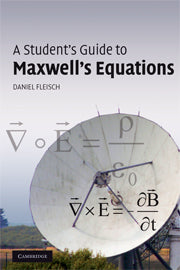A Student's Guide to Maxwell-s Equations
- Unit price
- / per
-
Author:Daniel Fleisch
-
ISBN:9780521701471
-
Publication Date:January 2008
-
Edition:1
-
Pages:
-
Binding:Paperback
-
Publisher:Cambridge University Press
-
Country of Publication:United Kingdom


A Back Order button means that we don’t have the book in stock at our store. It may already be on order – or we can order it for you from a publisher or distributor at no additional cost.
As we source items from around the globe, a back-order can take anywhere from 5 days to several weeks to arrive, depending on the title.
To check how long this might take, you’re welcome to contact us and we can provide an ETA or any other information you need. We recommend checking the timeframe before committing to an online order.
A Student's Guide to Maxwell-s Equations
- Unit price
- / per
-
Author:Daniel Fleisch
-
ISBN:9780521701471
-
Publication Date:January 2008
-
Edition:1
-
Pages:
-
Binding:Paperback
-
Publisher:Cambridge University Press
-
Country of Publication:United Kingdom
Description
Gauss's law for electric fields, Gauss's law for magnetic fields, Faraday's law, and the Ampere–Maxwell law are four of the most influential equations in science. In this guide for students, each equation is the subject of an entire chapter, with detailed, plain-language explanations of the physical meaning of each symbol in the equation, for both the integral and differential forms. The final chapter shows how Maxwell's equations may be combined to produce the wave equation, the basis for the electromagnetic theory of light. This book is a wonderful resource for undergraduate and graduate courses in electromagnetism and electromagnetics. A website hosted by the author at www.cambridge.org/9780521701471 contains interactive solutions to every problem in the text as well as audio podcasts to walk students through each chapter.
- Features an interactive website with complete solutions to every problem within the text, as well as audio podcasts explaining key concepts
- Plain-language explanations of the symbols used in the equations
- Modular approach allows reader to find relevant material easily
Adding product to your cart
You may also like
A Back Order button means that we don’t have the book in stock at our store. It may already be on order – or we can order it for you from a publisher or distributor at no additional cost.
As we source items from around the globe, a back-order can take anywhere from 5 days to several weeks to arrive, depending on the title.
To check how long this might take, you’re welcome to contact us and we can provide an ETA or any other information you need. We recommend checking the timeframe before committing to an online order.
You may also like
You may also like
-
Gauss's law for electric fields, Gauss's law for magnetic fields, Faraday's law, and the Ampere–Maxwell law are four of the most influential equations in science. In this guide for students, each equation is the subject of an entire chapter, with detailed, plain-language explanations of the physical meaning of each symbol in the equation, for both the integral and differential forms. The final chapter shows how Maxwell's equations may be combined to produce the wave equation, the basis for the electromagnetic theory of light. This book is a wonderful resource for undergraduate and graduate courses in electromagnetism and electromagnetics. A website hosted by the author at www.cambridge.org/9780521701471 contains interactive solutions to every problem in the text as well as audio podcasts to walk students through each chapter.
- Features an interactive website with complete solutions to every problem within the text, as well as audio podcasts explaining key concepts
- Plain-language explanations of the symbols used in the equations
- Modular approach allows reader to find relevant material easily
-
-
Author: Daniel FleischISBN: 9780521701471Publication Date: January 2008Edition: 1Pages:Binding: PaperbackPublisher: Cambridge University PressCountry of Publication: United Kingdom
Gauss's law for electric fields, Gauss's law for magnetic fields, Faraday's law, and the Ampere–Maxwell law are four of the most influential equations in science. In this guide for students, each equation is the subject of an entire chapter, with detailed, plain-language explanations of the physical meaning of each symbol in the equation, for both the integral and differential forms. The final chapter shows how Maxwell's equations may be combined to produce the wave equation, the basis for the electromagnetic theory of light. This book is a wonderful resource for undergraduate and graduate courses in electromagnetism and electromagnetics. A website hosted by the author at www.cambridge.org/9780521701471 contains interactive solutions to every problem in the text as well as audio podcasts to walk students through each chapter.
- Features an interactive website with complete solutions to every problem within the text, as well as audio podcasts explaining key concepts
- Plain-language explanations of the symbols used in the equations
- Modular approach allows reader to find relevant material easily
-
Author: Daniel FleischISBN: 9780521701471Publication Date: January 2008Edition: 1Pages:Binding: PaperbackPublisher: Cambridge University PressCountry of Publication: United Kingdom
-



